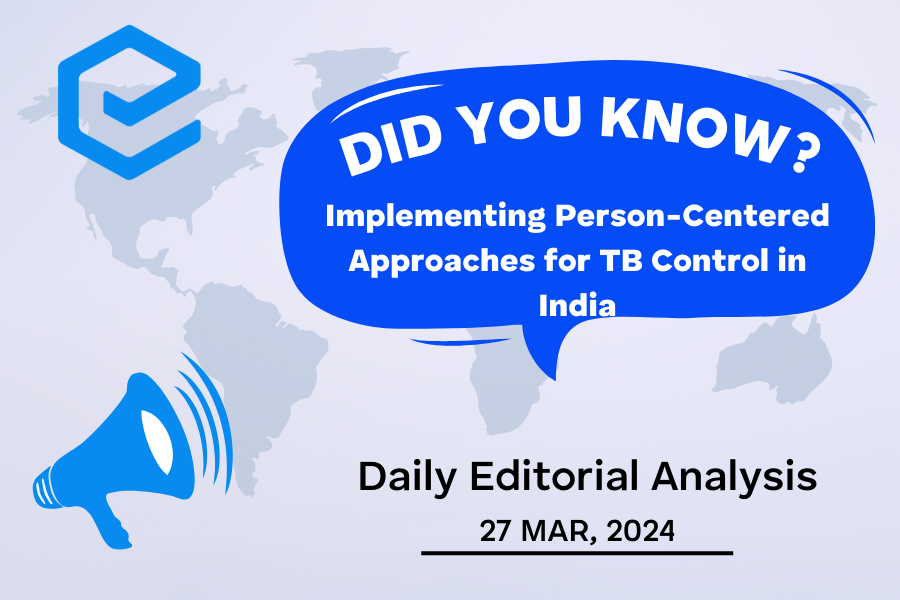
The implementation of person-centered approaches for tuberculosis (TB) control in India requires a multifaceted strategy that addresses the diverse needs of individuals affected by the disease. In this editorial analysis, it is crucial to recognize that TB control cannot be solely reliant on traditional medical interventions but must also incorporate social, economic, and cultural factors into its framework. By placing individuals at the center of TB control efforts, policymakers can ensure that interventions are tailored to meet the specific needs of communities, including marginalized groups who may face barriers to accessing healthcare. Moreover, fostering partnerships with local communities and healthcare providers can enhance the effectiveness of TB control programs by promoting trust, increasing awareness, and facilitating early detection and treatment. Ultimately, a person-centered approach to TB control in India holds the potential to not only improve health outcomes but also address the broader social determinants that contribute to the spread of the disease.
Tag: GS – 2 Health, Government Policies & Interventions, Important International Institutions
In News: A recent article examines the ongoing public health issue of tuberculosis (TB) globally, with a focus on India.
Contents
- 1 Tuberculosis (TB) Burden in India: Challenges and Solutions
- 2 Conclusion
- 3 Frequently Asked Questions (FAQs)
- 3.1 1. Why is a person-centered approach essential for TB control in India?
- 3.2 2. How does a person-centered approach address the socio-economic challenges associated with TB in India?
- 3.3 3. What role do local communities play in person-centered TB control efforts in India?
- 3.4 4. How can healthcare providers implement person-centered approaches in TB control programs?
- 3.5 5. What are the potential benefits of implementing person-centered approaches for TB control in India?
- 4 In case you still have your doubts, contact us on 9811333901.
Tuberculosis (TB) Burden in India: Challenges and Solutions
TB Burden in India: A Global Concern
- India accounts for 27% of global TB cases, despite TB being detectable and curable.
- TB is caused by the bacterium Mycobacterium tuberculosis, predominantly affecting the lungs but also other organs.
- TB remains the top infectious killer globally, causing 1.5 million deaths annually.
Challenges in Curing TB Burden in India
- Medicalization Over Humanitarianism
- TB has often been overly medicalized, neglecting its broader societal and humanitarian impacts.
- Disproportionate Impact on Marginalized Groups
- TB disproportionately affects marginalized populations, exacerbating social and economic disparities.
- Antibiotic Misuse and Drug Resistance
- Unregulated antibiotic use and non-compliance contribute to drug-resistant TB strains.
- Limited Access to Diagnostic Testing
- Cost and accessibility issues hinder widespread molecular testing for TB.
- TB-Diabetes Mellitus (DM) Dual Burden
- The coexistence of TB and DM poses additional challenges to treatment outcomes and healthcare systems.
Steps to Address the TB Crisis
- Prioritize Patient-Centric Approaches
- Focus on patient needs and community engagement within the healthcare system.
- Bridge Policy Intent with Ground Realities
- Implement targeted interventions to improve TB diagnosis and treatment accessibility.
- Strengthen Community-Based Care
- Empower frontline healthcare workers to provide comprehensive, holistic care.
- Adopt Multi-Sectoral Approaches
- Address socio-economic determinants of TB through collaborative efforts across sectors.
- Leverage Technology and Innovation
- Utilize AI and digital health solutions to enhance TB diagnosis, treatment, and surveillance.
- Implement an 8-Point Agenda for TB Control
- Prioritize early detection, precise treatment categorization, treatment adherence, and mortality reduction.
- Ensure Availability of Appropriate Medicines
- Address procurement challenges for drug-resistant TB medications and ensure treatment facilities.
- Consider Population Mobility and Migration
- Ensure portability of TB treatment and strengthen referral networks to address mobility issues.
Conclusion
- Eliminating TB in India requires a comprehensive, person-centered approach addressing social determinants of health and embracing innovation.
- Emphasizing streamlined implementation and proactive adoption of new technologies is crucial to overcoming barriers and creating a healthier future for all citizens.
Source: TH
Frequently Asked Questions (FAQs)
1. Why is a person-centered approach essential for TB control in India?
- Answer: A person-centered approach ensures that TB control strategies consider individual needs, circumstances, and barriers to accessing healthcare, leading to more effective interventions tailored to diverse communities.
2. How does a person-centered approach address the socio-economic challenges associated with TB in India?
- Answer: By focusing on the individual, this approach acknowledges and addresses socio-economic factors such as poverty, stigma, and access to healthcare, which significantly impact TB prevention, diagnosis, and treatment outcomes.
3. What role do local communities play in person-centered TB control efforts in India?
- Answer: Local communities are integral partners in TB control as they possess valuable insights into community dynamics, cultural norms, and potential barriers to healthcare access. Engaging communities fosters trust, improves awareness, and promotes early detection and treatment.
4. How can healthcare providers implement person-centered approaches in TB control programs?
- Answer: Healthcare providers can adopt person-centered practices by offering patient-centered care, respecting individual preferences, addressing socio-economic needs, and providing culturally sensitive education and support throughout the TB care continuum.
5. What are the potential benefits of implementing person-centered approaches for TB control in India?
- Answer: Person-centered approaches have the potential to improve TB treatment adherence, reduce stigma, enhance early detection rates, and ultimately contribute to more effective control and elimination of TB in India by addressing the holistic needs of individuals and communities.
In case you still have your doubts, contact us on 9811333901.
For UPSC Prelims Resources, Click here
For Daily Updates and Study Material:
Join our Telegram Channel – Edukemy for IAS
- 1. Learn through Videos – here
- 2. Be Exam Ready by Practicing Daily MCQs – here
- 3. Daily Newsletter – Get all your Current Affairs Covered – here
- 4. Mains Answer Writing Practice – here

